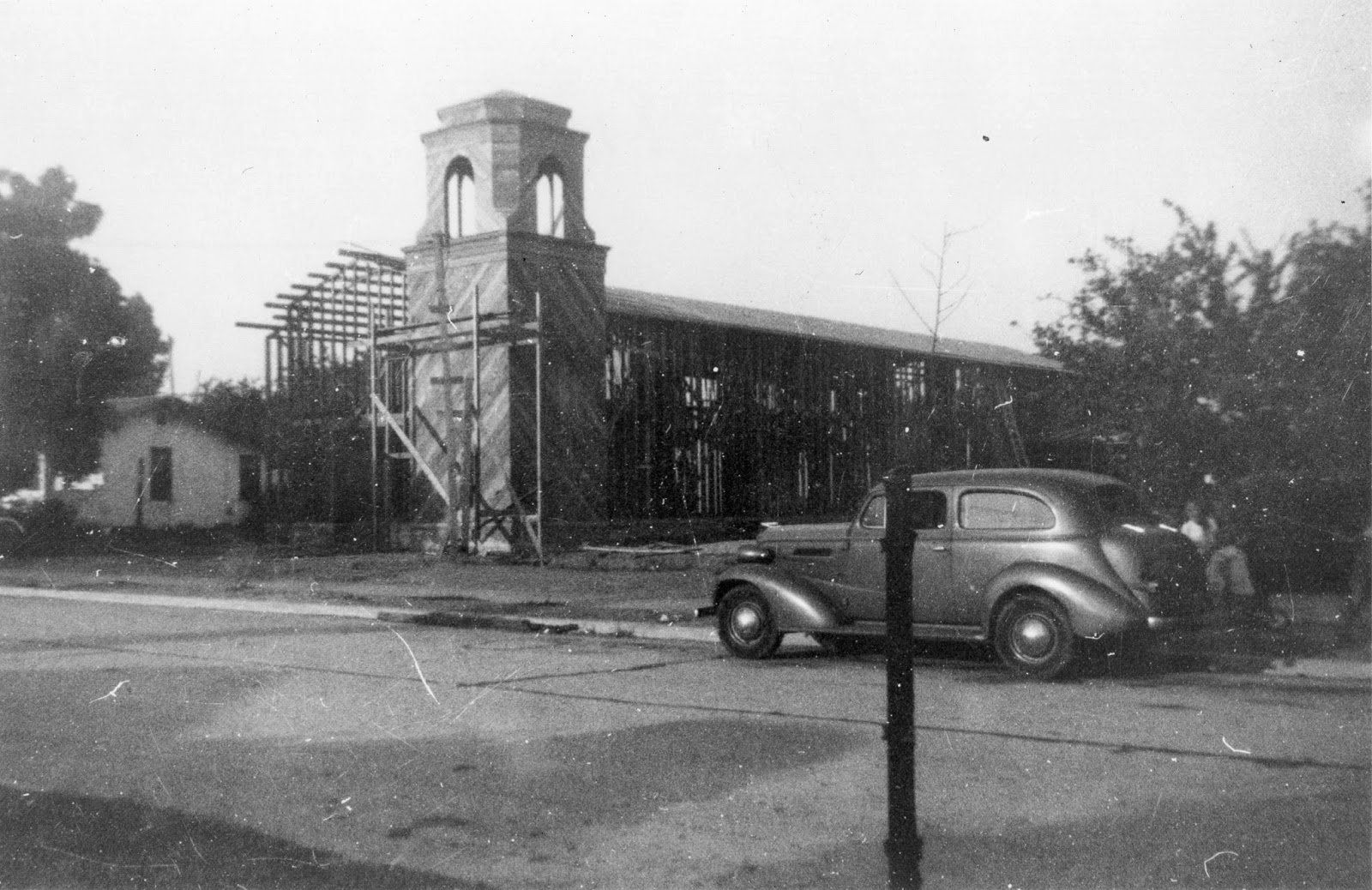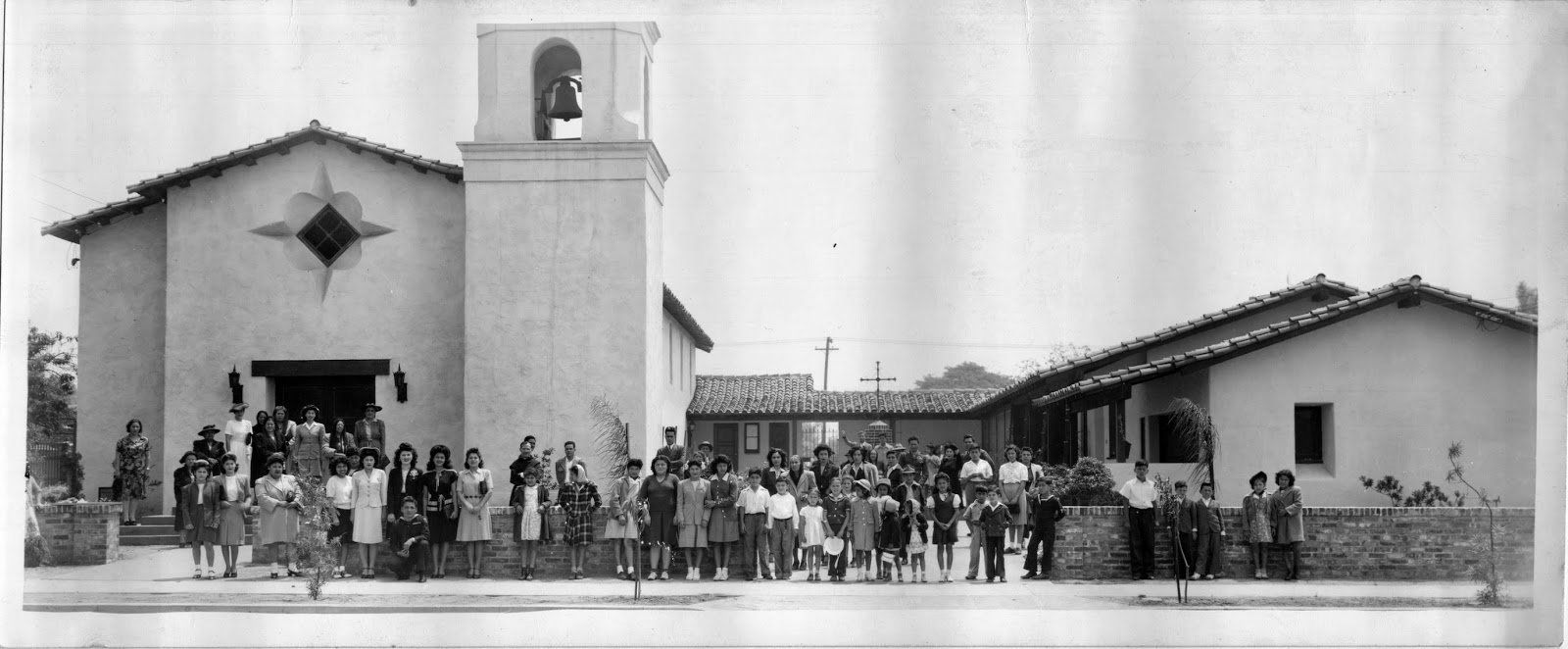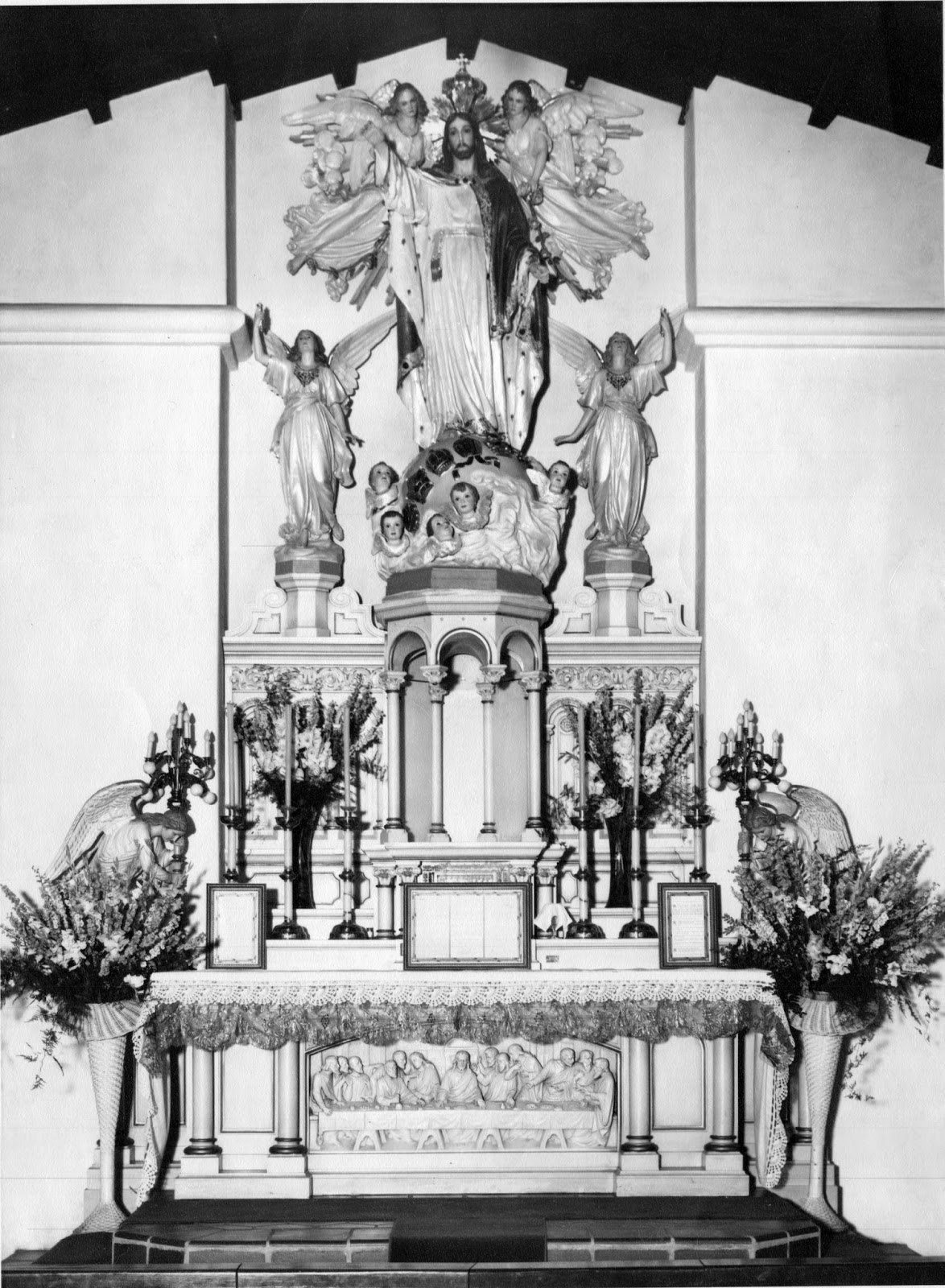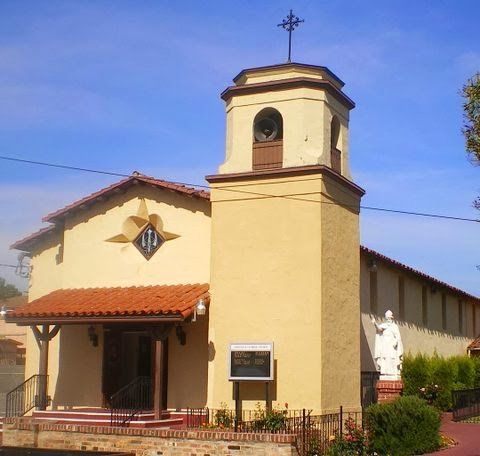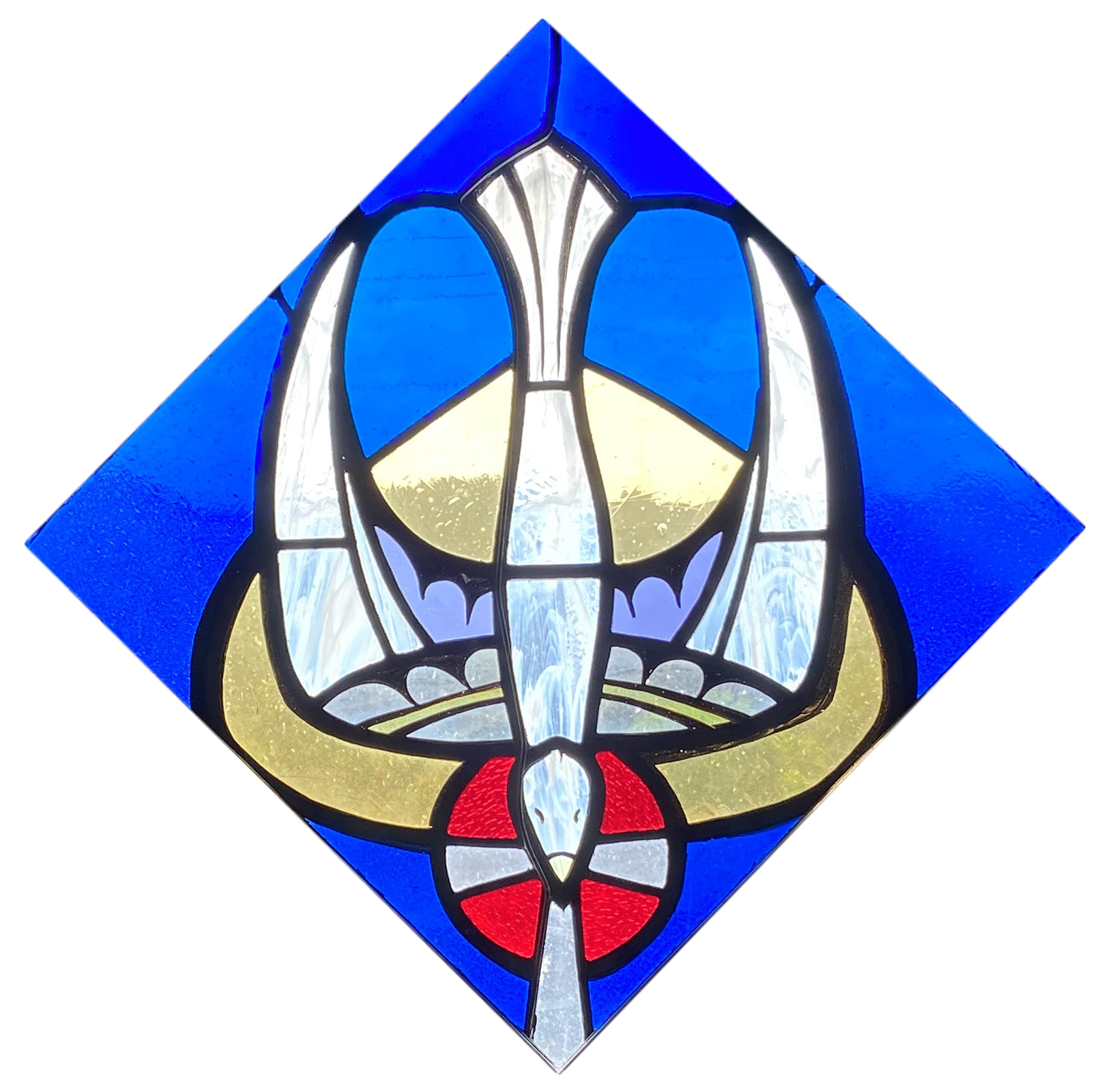History / Historia
Cristo Rey History/ La Historia de Cristo Rey
The Augustinian Recollects have enjoyed a long and wonderful history at Cristo Rey. It was through the vision of this religious community that permission was granted for Fr. Jesus Domench, O.A.R. to begin ministering to the needs of the Hispanic Catholics in the north-eastern section of Los Angeles.
The first Masses were celebrated in a small rented house on Baywood Street. When the number of faithful attending Masses was too large for the house, Mass was moved to the patio area under a tent. Later, Sunday Masses were held in a local dance hall on the corner of Chevy Chase and Brand, and eventually at nearby Holy Trinity Church.
The construction of Cristo Rey Church is closely connected to the Verdugo Days Fiesta, which began in 1938. The Verdugo Days Fiesta was initially organized to raise funds for a recreation center in Glendale for the Azteca Boys Club and to purchase the land for the construction of Cristo Rey Church.
Los Agustinos Recoletos han gozado una larga y maravillosa historia en Cristo Rey. Fue a través de la visión de esta comunidad religiosa que dieron permiso al Padre Jesús Domench, O.A.R. A comenzar el ministerio para ayudar a la comunidad de católicos hispanos en el área de noroeste de Los Ángeles.
Las primeras misas fueron celebradas en una pequeña casa rendada en la calle Baywood. Cuando el número de fieles que asistían creció demasiado, la Misa fue traslada al patio bajo una carpa. Después las Misas se celebraban en un salón local de baile en la esquina de Chevy Chase y Brand, y después cerca de la Iglesia de Holy Trinity.
La construcción de La Iglesia de Cristo Rey está conectada muy cerca con los días de la Fiesta de Verdugo que comenzó en 1938. La Fiesta de Verdugo fue iniciada para recaudar fondos para el Centro de Recreación en Glendale para Los Azteca Boys Club y para comprar terreno para la construcción de la Iglesia de Cristo Rey.
A meeting was held on a Sunday afternoon for residents of southern Glendale and Atwater, and this was the beginning of the Glendale Fiesta Association. Also present was a group of women from the same area who had formed a group, Confederacion Feminina Catolica Mexicana, under the leadership of Mrs. Frances Ramirez. The group's goal was to obtain a Spanish-speaking priest to serve in the community and eventually build a church of their own.
It was during this meeting that Lt. R.E. Warwick of the Glendale Crime Prevention Bureau and Mr. Ray Lobleto, leader of the Aztec Boys Club, suggested that a fiesta be held to support both groups. Everyone present at this meeting was enthusiastic about this joint venture and called for another meeting to be held at El Ruby Cafe, which was operated by Salvador and Maria Velasquez.
The first meeting of these groups was held on the feast of Christ the King, and for this reason, the members of the Confederacion decided that the church to be constructed in the future should be dedicated in honor of Christ the King. Thus they chose the title “Cristo Rey,” which is so dear to the Hispanic community.
The first “Days of Verdugo” was held in September of 1938 with Consuelo Velasquez crowned as queen following a parade down Brand Boulevard. Over the years, the excitement for the fiestas grew as people realized the needs to be met. By 1941, the Catholics of southern Glendale and Atwater had raised $4,000 to purchase four lots on Perlita Avenue as the site for a new church.
It was difficult time with limited funds and resources during the Second World War. There were supply shortages and other troubles in obtaining lumber and building materials. The parishioners had to be dedicated and vigilant while the church was being built. For example, Mr. Teodoro Estrada would sleep in his car behind the church construction site, accompanied by the family dog, to guarantee that none of the lumber for the new church would be stolen. Only once did someone attempt to rob the lumber, but Mr. Estrada and his dog were able to apprehend the culprit.
Numerous activities were held to meet the expenses for the construction, including dinners, dances, jamaicas and fiestas. The Annual Queen Coronation Dance was a festive event that brought the community together and raised funds to finish building the church.
It was a joyous occasion when Archbishop John J. Cantwell solemnly dedicated Cristo Rey Church on March 12, 1944. The early parishioners were proud of their accomplishments and the faith that had sustained the community. They knew that God would bless their sacrifices and allow their parish to grow. That same year the Rectory was built as a residence for the Augustinian Recollect priests serving in the parish.
Un domingo hubo una junta para los residentes de Glendale y Atwater, este fue el comienzo de la Asociación de Fiesta en Glendale. También estuvo presente un grupo de mujeres de la misma área que formaron el grupo Confederación Femenina Católica Mexicana, bajo el liderazgo de la Sra. Frances Ramírez. El propósito del grupo era para conseguir un sacerdote de habla español que sirviera en la comunidad y para la construcción de una iglesia que pudieran sentir como propia.
Fue durante esta junta que el teniente R.E. Warwick del Departamento para Prevención de Crímenes
De Glendale y el Sr. Ray Lobleto, líder del Aztec Boys Club, sugirieron que una fiesta se llevase a cabo para apoyar los dos grupos. Todos los presentes se entusiasmaron por la colaboración y decidieron hacer otra junta en El Ruby Café, que era manejado por Salvador y María Velásquez.
La primera junta de estos grupos se llevó acabo el día de la Fiesta de Cristo Rey, por esta razón los miembros de la Confederación decidió que la construcción de la futura Iglesia fuera dedicada en honor de Cristo Rey. Este día fue de gran significado por el título de Cristo Rey, tan querido por la comunidad Hispana.
Los primeros “Días de Verdugo” se celebró en Septiembre del 1938 Consuelo Velásquez fue coronada come reina luego hubo un desfile en la calle Brand Blvd. Pasando los años el entusiasmo por las fiestas creció cuando la gente se dio cuenta de las necesidades que existían. En 1941, los católicos de Glendale y Atwater habían recaudado $4,000 para comprar lotes en Perlita Avenue como el sitio para la nueva Iglesia.
Los tiempos eran difíciles los fondos y los recursos eran limitados durante la Segunda Guerra Mundial. La carencia y la dificultad para conseguir madera y materiales de construcción. Los feligreses debían ser dedicados y vigilantes mientras se construía la Iglesia. Por ejemplo, El Sr. Teodoro Estrada dormía en su carro con su perro detrás del sitio donde se construía la Iglesia, para cuidar que no se robaran la madera, solamente una vez intentaron robar la madera, pero El Sr. Estrada y su perro pudieron detener al delincuente.
Numerosas actividades se hicieron para poder pagar el costo de la construcción, se hicieron, cenas, biales, Jamaica y fiestas. La Coronación anual y baile de la Reina fue un evento que unió a toda la comunidad y ayudo mucho para recaudar fondos para poder terminar la Iglesia.
Throughout the years, additional furnishings for the church were purchased, especially the beautiful statues that adorn the interior. The Stations of the Cross and various images of our Blessed Mother were bought with donations from parishioners, and many were brought from Spain whenever Augustinian Recollects would be returning to the United States.
Soon after the construction of the church, the Augustinian Recollects dreamed of a statue of their patron, St. Augustine, for the exterior of the church and, in 1954, the marble stature of St. Monica was installed in front of the Rectory.
Due to limited funds, the purchasing of statues for the church was a slow process, as evident in the range of dates. The statue of Our Lady of San Juan de los Lagos was the first to be blessed on October 12, 1957, and the statue of Nuestra Señora del Cobre was the last to be blessed on December 8, 1973.
The mosaic of Our Lady of Guadalupe was blessed and installed on April 11, 1976. Mr. and Mrs. Feliciano De Leon were the impetus behind this special project and invited other members of the parish to contribute. Prior to the installation of the mosaic, parishioners who donated to the project had the chance to write their names on the back side of mosaic.
Fue una ocasión muy gozosa cuando el Arzobispo J. Cantwell dedico la Iglesia de Cristo Rey el 12 de Marzo del 1944. Los primeros feligreses estaban muy orgullosos por sus logros y la fe que mantuvo la comunidad. Sabían que Dios bendeciría sus sacrificios y la Iglesia crecería. El mismo año se construyó la Rectoría como residencia para los Sacerdotes Agustinos Recoletos que servirían en la Iglesia.
Atreves de los años se fueron comprando muebles y otros accesorios para la Iglesia, y las bellas estatuas que adornan el interior. Las Estaciones de la Cruz y varias imágenes de Nuestra Madre Santísima fueron compradas con donaciones de los feligreses, muchos fueron traídas de España por los Agustinos Recoletos cuando volvían a los Estados Unidos.
Poco después de las construcción de la Iglesia los Agustinos Recoletos sonaron con colocar la imagen de su patrón, San Agustín en el exterior de la Iglesia. En 1954 la estatua de mármol de Santa Mónica fue instalada en frente de la Rectoría.
Los fondos eran muy limitados la compra de las estatuas de la Iglesia fue un proceso lento, es evidente en las fechas tan distanciadas. La estatua de Nuestra Señora de San Juan de los Lagos fue la primera que se bendigo el día 12 to octubre del 1957, y la estatua de Nuestra Señora del Cobre fue la última que se bendigo el 8 de Diciembre del 1973.
In later years, additional property was purchased on LaClede for a much-needed parking lot, and it was on this same site that a parish hall was built in 1961. The construction of the parish hall found the parishioners responding with their usual generosity, especially when they realized that it would serve as a Catechism Center for the young members of the parish.
Today the parish hall serves to bring our community together for a variety of events including Sunday breakfast, meetings and performances by the parish theatrical group, “Cristo Siempre.” The most important function of the parish hall continues to be the education of our young people in the Catholic Faith and Sacramental Preparation. Religious Education classes are held there six days each week in both English and Spanish sessions.
The feast of Cristo Rey in 2008 was enhanced by the blessing of the new bell for the church tower. Early photographs of the church with a bell in the tower prompted interest in returning a bell to the tower and removing the speakers from the carillon system. The “Bell Project” became a community effort. The children in the Religious Education classes contributed their coins, knowing that their gifts would be part of something they could recall in the future.
The work that Fr. Domench began has continued throughout the years by numerous Augustinian Recollects, working with the dedicated parishioners of Cristo Rey. This little community that began with the status as a “mission” of neighboring parishioners continued to grow in numbers and in a vibrant faith.
El mosaico de Nuestra Señora de Guadalupe fue bendecido e instalado el 11 de Abril del 1976. El Sr. Y Sra. Feliciano De León fueron los principales que apoyaron este proyecto tan especial, e invitaron a otros miembros de la parroquia a que contribuyeran. Antes de la instalación del mosaico, los feligreses que donaron para el proyecto tuvieron la oportunidad de escribir sus nombres detrás del mosaico.
Años más tarde, se compraron propiedades adicionales en la calle LaClede para un muy necesitado estacionamiento, en el mismo sitio se construyó el salón parroquial, los feligreses respondieron muy generosamente aún más cuando se dieron cuenta que iba a servir como un centro para el Catecismo para los miembros jóvenes de la parroquia.
Hoy el Salón Parroquial sirve para unir a nuestra comunidad en varios eventos, incluyendo ventas de comida los domingos, juntas, actuaciones y ensayos del grupo teatral de la parroquia: “Cristo Siempre”. La función más importante del salón parroquial continuara siendo la educación religiosa de nuestros jóvenes en La Fe Católica y la Preparación para los Sacramentos. Las clases de religión son síes días a la semana en Ingles y en Español.
La fiesta de Cristo Rey en 2008 fue elevada con la bendición de la nueva campana en la torre de la Iglesia. Fotos de la Iglesia con la campana en la torre levanto el interés de regresar la campana a la torre y removiendo las bocinas del sistema del carrillon que hacia tiempo no funcionaba. El “Proyecto Campana” se convirtió en esfuerzo de comunidad. Los niños del Programa de Religión contribuyeron con sus monedas, sabiendo que su regalo seria para memorable en el futuro.
El trabajo que el Padre Domench comenzó continua atreves de los años por numerosos Agustinos Recoletos, trabajando con los parroquiales dedicados a Cristo Rey. Esta pequeña comunidad que comenzó como una “misión” de feligreses vecinos continúa creciendo en número y fe ardiente.
